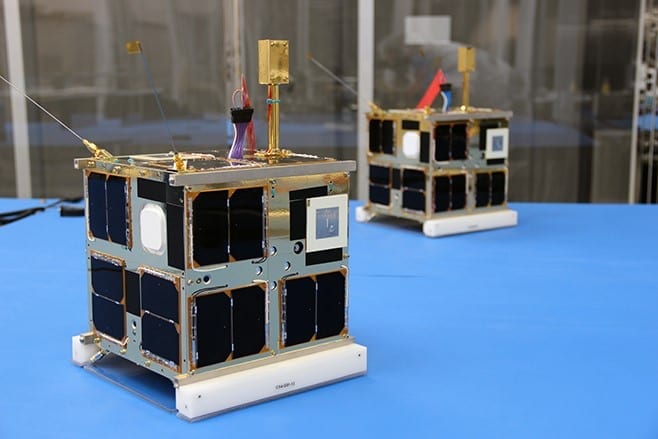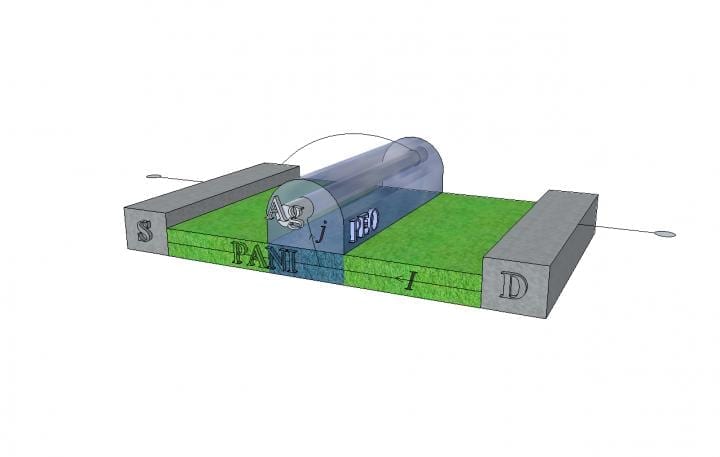
SFL and DSI demonstrate enabling technology for low-cost asteroid missions and constellations
The world’s first demonstration of autonomous spacecraft maneuvering was recently completed by Silicon Valley-based Deep Space Industries (DSI) and the Space Flight Laboratory (SFL) of Toronto, Canada. Using their highly-successful CanX-4 and CanX-5 pair of nanosatellites, SFL operators executed a DSI-defined experiment on-orbit, in which the world’s first spacecraft-to-spacecraft orbit maneuver was commanded by one satellite and executed by the other.
In this experiment, one of the two spacecraft (CanX-4) autonomously programmed the other (CanX-5) to perform an orbit change using its on-board propulsion system, over a shared S-band Inter-Satellite Link (ISL) radio. CanX-5 subsequently executed the maneuver, raising its orbit, as confirmed by operators at SFL’s Mission Control Center (MCC) in Toronto and data from the Joint Space Operations Center (JSpOC) at Vandenberg Air Force Base.
To the best of each organization’s knowledge, this is the first time in history that one satellite has autonomously commanded another to execute propulsive maneuvers, with no operator in the loop.
“This experiment was a key demonstration of a critical capability for multi-spacecraft asteroid missions, as well as constellations of spacecraft in Earth orbit,” said Grant Bonin, DSI’s Chief Engineer. “It was also a first step in demonstrating ship-to-shore command relay in-space, which could potentially reduce the difficulty of communicating with very small spacecraft at long range.”
“The experiment was an important risk reduction exercise for DSI, which intends to use small spacecraft for initial asteroid prospecting missions in the next five years,” Bonin continued. “The ability to relay commands from spacecraft to spacecraft, and perform in-space maneuvers autonomously, without operator intervention, is a critical capability that has major implications for mission-level redundancy—not just for asteroid missions, but also for low-cost Earth orbit constellations. This also shows that, if necessary, we can take the operator entirely out of the loop during a mission, which can translate into significant savings.”
Read more: Deep Space Industries teams with UTIAS Space Flight Laboratory to demonstrate autonomous spacecraft maneuvering – via Deep Space Industries
The Latest on: Nanosatellites
[google_news title=”” keyword=”nanosatellites” num_posts=”10″ blurb_length=”0″ show_thumb=”left”]
via Google News
The Latest on: Nanosatellites
- Florida Atlantic University selected for NASA nanosatellite projecton May 2, 2024 at 11:13 am
According to Oscar Curet, College of Engineering & Computer Science associate professor and student mentor, a CubeSat is among a class of research spacecraft called nanosatellites about the size ...
- Korea’s homegrown nanosatellite successfully launches into spaceon May 1, 2024 at 9:45 am
South Korea launched its first homegrown earth observation nanosatellite into orbit as part of the country’s project to create a satellite constellation by 2027, the Science Ministry said Wednesday.
- Portal Space Systems comes out of stealth with satellites that’ll be fired up by the sunon April 30, 2024 at 6:24 am
Portal Space Systems is emerging from stealth with a plan to create a satellite platform that uses the sun's heat to spark its thrusters.
- South Korea launches nanosatellite from New Zealandon April 24, 2024 at 10:33 am
Earth observation satellite lifted off aboard Rocket Lab's Electron rocket from spaceport in Mahia, New Zealand ...
- S. Korea to launch 1st nanosatellite this weekon April 24, 2024 at 12:55 am
South Korea is set to launch a homegrown earth observation nanosatellite into space this week, as part of its plan to create the country's satellite constellation by 2027, the science ministry said ...
- Korea launches first nanosatellite to boost surveillance over peninsulaon April 24, 2024 at 12:34 am
Following this satellite launch, Korea plans to launch an additional five nanosatellites in both 2026 and 2027. The science ministry added those launches will be carried out by Korea's space launch ...
- South Korea Launches Nanosatellite For Satellite Constellation Projecton April 23, 2024 at 11:35 pm
A South Korean nanosatellite was launched into orbit as part of the nation's project to create a satellite constellation by 20 ...
- (2nd LD) S. Korea's nanosatellite launched from New Zealand for satellite constellation projecton April 23, 2024 at 4:49 pm
A South Korean nanosatellite was launched into orbit as part of the nation's project to create a satellite constellation by 2027, officials said Wednesday. The Earth observation satellite lifted off ...
- Nanosatellite and Microsatellite Market CAGR of 20.1%, Segmentation Analysis, Growth, Share, Trends, Size and Forecast to 2024 to 2032on April 19, 2024 at 1:08 am
report_id=bw674 Besides these usages, nanosatellites and microsatellites are also utilized in defense, military sector and for commercial purposes. Nanosatellites and microsatellites are basically ...
- KhalifaSat: the first Emirati satellite built from ground upon February 17, 2021 at 7:53 pm
These include an astronaut program, the development of nanosatellites and a Mars probe. Photograph courtesy Mohammed Bin Rashid Space Centre “When we started KhalifaSat we grew as a team and ...
via Bing News









